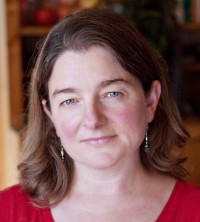Lessons for "Our Whole Lives" Church-based sex ed: Church-based sex ed

Read the main article on comprehensive sex ed
When Nicole Chaisson teaches fifth- and sixth-graders about sexuality at Macalester Plymouth United Church in St. Paul, she doesn’t have to worry about what the state legislature might say. She is not relying on federal funding, and no organization will ask her to demonstrate the results. But her relative freedom doesn’t make her task simple.
On this Sunday evening, the session is about puberty, and the six girls and five boys in attendance are giggling nervously. They seem both comfortable at being there and anxious about the conversation about to take place. The anxiety is eventually voiced by one child by way of a question placed in an anonymous question box: “Why do we need to learn about puberty?”
Read our latest issue or browse back issues.
Chaisson is a pediatrician known to her church’s youth as “the sex lady.” Along with Plymouth’s pastor, Tom Ewald, she has been trained to teach the Our Whole Lives curriculum jointly produced by the United Church of Christ and the Unitarian Universalist Association. It is considered by many teachers in the field as one of the best, most comprehensive sexuality curricula available. Chaisson is offering a version of the curriculum that can be taught in eight lessons. (The version recommended for students in grades seven to nine includes 29 lessons.)
Chaisson spreads out three large sheets of paper on a table. One says “Boys,” one says “Girls” and one says “Both.” Aspects of puberty are written on index cards. Each child is asked to read an aspect aloud and place it on the appropriate sheet. “Hair grows on the body” goes under “Both,” while “Breasts grow bigger” goes under “Girls.”
The simple exercise aims to accomplish several things. First, it offers a basic anatomy and biology lesson. Second, it communicates an important concept—that it is perfectly normal for the body to go through these changes. Third, in learning to pronounce and define words like scrotum and genitalia, the children gain fluency with a vocabulary—one that their teachers and parents hope will become second nature to them and allow them to talk more readily about their physical, emotional and spiritual health. Fourth, the exercise aims to convey a sense of equality and mutuality. By the end of the lesson, the vast majority of the cards are piled up in the category “Both.” The students should recognize that girls and boys experience dramatic changes that are remarkably similar, as well as some that are particular to each gender.
When the creators, trainers and teachers of Our Whole Lives talk about “comprehensive” sexuality education, this is what they mean. They want to teach multilayered, values-oriented lessons that convey a positive view of sex. T. Michael Rock, pastor of Robbinsdale UCC in a suburb of Minneapolis, says that five aspects of sexuality are addressed in the curricula in “age-appropriate ways”: sexuality itself (i.e., the biology of the matter), sexualization (how the culture treats sexuality), sensuality, intimacy and sexual identity. Our Whole Lives was created to function in both secular and church settings. It encourages specific values, namely, self-worth, sexual health, responsibility, justice and inclusivity.
All this sounds great on paper. Now take it up with 11 squirrely young people, who immediately divide themselves into a boy section and a girl section. When Chaisson hands one girl a card that says “Menstruation begins” and asks her to read it out loud, the girl balks. Chaisson keeps at it. One boy moans, “This is hard to comprehend.” Sex education is hard work, whether done in schools, churches or at home.
At Robbinsdale UCC, an older group of students is working on the notion of “consent” (it’s lesson 12 in the grades seven-to-nine curriculum of Our Whole Lives). The teachers have quieted the rambunctious ones and settled the group into a role-playing exercise. Small groups are asked to perform a skit about consent. In one case, an older brother asks a younger brother to lie for him; in another, one teen asks another to go to a concert; in a third, a boy asks a girl to have sex.
In these dramas, the young people search for the words to say yes and no. The younger brother agrees to lie, the teen can’t say no to the concert, the girl (played in this case by a boy) consents to going to the boy’s house but blurts out, “Only don’t try to intercourse me!”—at which everyone explodes with laughter. The students seem to agree that saying no can be a challenge. Pastor Michael’s closing prayer validates their efforts, but he can’t make the topic easy.
Despite the challenges, parents and teachers who use Our Whole Lives are passionate about the importance of sex education in church settings. Rob Ramir, a parent at Plymouth UCC, says he wants his son, Amir, to learn about sexuality in a way that recognizes its spiritual as well as its physical nature. “As the parent and grandparent of boys, I wanted them to understand responsibility and the depths of relationships and the need for equality and mutual respect. I consider those our Christian values, and OWL puts those in very plain terms.”
Ann Hanson, minister for sexuality education and justice in the UCC, has been working on sexuality education for 40 years. She thinks the need for sex education is greater now than ever.
“I was raised in a time when opportunities for holistic sexuality education were few and far between, and we have yet to have the conversation that really can guide youth and children,” Hanson said. “When you throw in rape culture, the Internet, advertising and the seduction of consumer culture, the situation is obviously more dire. . . . I want our youth to get their information from people who communicate to them that they are whole people of God.”







